Financial Performance of CSR Limited: Capital Structure Impact
VerifiedAdded on 2023/04/25
|26
|6278
|365
Report
AI Summary
This report investigates the impact of capital structure on the financial performance of CSR Limited, an ASX-listed company. The study analyzes the relationship between debt, equity, and key financial metrics such as Return on Assets (ROA), Return on Equity (ROE), and Earnings Per Share (EPS). The research employs both qualitative and quantitative data, drawing on secondary sources like annual reports and official websites. The analysis reveals that CSR Limited's capital structure has a significant effect on its financial performance, highlighting areas for improvement in capital management. The report includes a literature review of relevant theories, a detailed research methodology, data analysis involving income statements, balance sheets, ratio analysis, descriptive statistics, correlation, and regression. The findings suggest that changes in capital structure can positively influence the company's financial outcomes. Ultimately, the report recommends adjustments to CSR Limited's capital structure policies to enhance its financial performance and provides conclusions and limitations of the study.

Running head: IMPACT OF CAPITAL STRUCTURE ON THE FINANCIAL
PERFORMANCE OF CSR LIMITED
Impact of Capital Structure on the Financial Performance of CSR Limited
Name of the Student:
Name of the University:
Author’s Note:
PERFORMANCE OF CSR LIMITED
Impact of Capital Structure on the Financial Performance of CSR Limited
Name of the Student:
Name of the University:
Author’s Note:
Paraphrase This Document
Need a fresh take? Get an instant paraphrase of this document with our AI Paraphraser
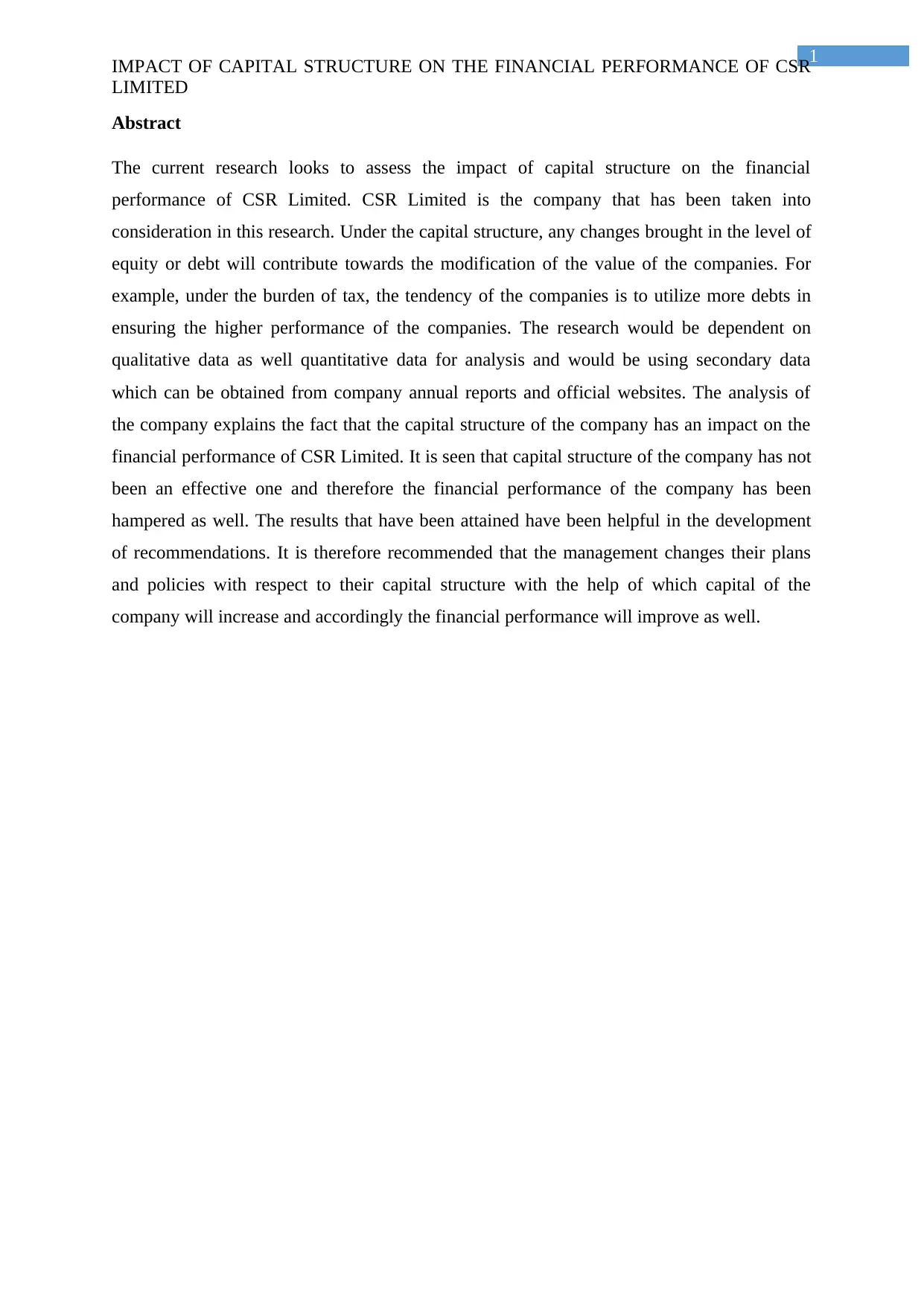
1
IMPACT OF CAPITAL STRUCTURE ON THE FINANCIAL PERFORMANCE OF CSR
LIMITED
Abstract
The current research looks to assess the impact of capital structure on the financial
performance of CSR Limited. CSR Limited is the company that has been taken into
consideration in this research. Under the capital structure, any changes brought in the level of
equity or debt will contribute towards the modification of the value of the companies. For
example, under the burden of tax, the tendency of the companies is to utilize more debts in
ensuring the higher performance of the companies. The research would be dependent on
qualitative data as well quantitative data for analysis and would be using secondary data
which can be obtained from company annual reports and official websites. The analysis of
the company explains the fact that the capital structure of the company has an impact on the
financial performance of CSR Limited. It is seen that capital structure of the company has not
been an effective one and therefore the financial performance of the company has been
hampered as well. The results that have been attained have been helpful in the development
of recommendations. It is therefore recommended that the management changes their plans
and policies with respect to their capital structure with the help of which capital of the
company will increase and accordingly the financial performance will improve as well.
IMPACT OF CAPITAL STRUCTURE ON THE FINANCIAL PERFORMANCE OF CSR
LIMITED
Abstract
The current research looks to assess the impact of capital structure on the financial
performance of CSR Limited. CSR Limited is the company that has been taken into
consideration in this research. Under the capital structure, any changes brought in the level of
equity or debt will contribute towards the modification of the value of the companies. For
example, under the burden of tax, the tendency of the companies is to utilize more debts in
ensuring the higher performance of the companies. The research would be dependent on
qualitative data as well quantitative data for analysis and would be using secondary data
which can be obtained from company annual reports and official websites. The analysis of
the company explains the fact that the capital structure of the company has an impact on the
financial performance of CSR Limited. It is seen that capital structure of the company has not
been an effective one and therefore the financial performance of the company has been
hampered as well. The results that have been attained have been helpful in the development
of recommendations. It is therefore recommended that the management changes their plans
and policies with respect to their capital structure with the help of which capital of the
company will increase and accordingly the financial performance will improve as well.
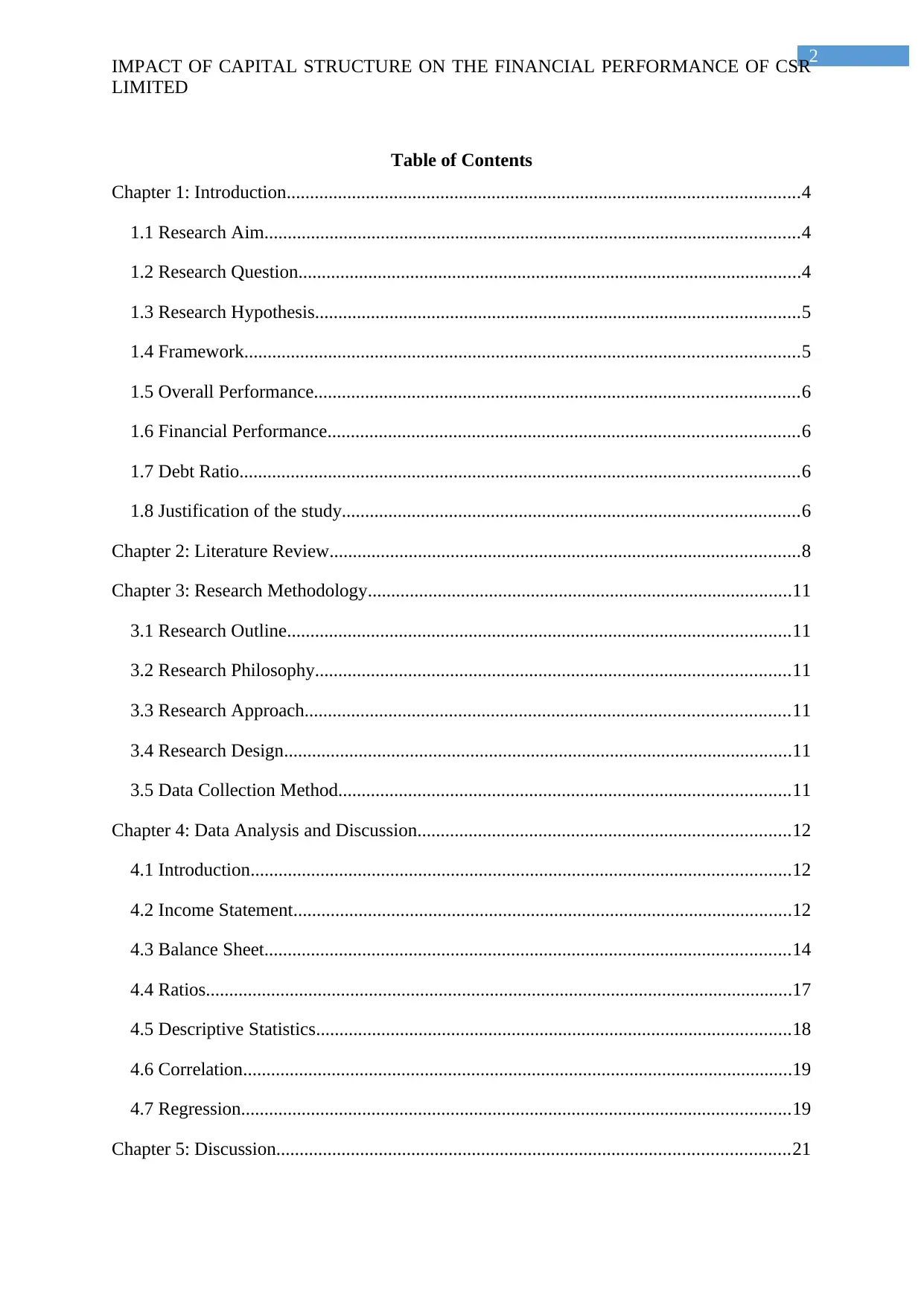
2
IMPACT OF CAPITAL STRUCTURE ON THE FINANCIAL PERFORMANCE OF CSR
LIMITED
Table of Contents
Chapter 1: Introduction..............................................................................................................4
1.1 Research Aim...................................................................................................................4
1.2 Research Question............................................................................................................4
1.3 Research Hypothesis........................................................................................................5
1.4 Framework.......................................................................................................................5
1.5 Overall Performance........................................................................................................6
1.6 Financial Performance.....................................................................................................6
1.7 Debt Ratio........................................................................................................................6
1.8 Justification of the study..................................................................................................6
Chapter 2: Literature Review.....................................................................................................8
Chapter 3: Research Methodology...........................................................................................11
3.1 Research Outline............................................................................................................11
3.2 Research Philosophy......................................................................................................11
3.3 Research Approach........................................................................................................11
3.4 Research Design.............................................................................................................11
3.5 Data Collection Method.................................................................................................11
Chapter 4: Data Analysis and Discussion................................................................................12
4.1 Introduction....................................................................................................................12
4.2 Income Statement...........................................................................................................12
4.3 Balance Sheet.................................................................................................................14
4.4 Ratios..............................................................................................................................17
4.5 Descriptive Statistics......................................................................................................18
4.6 Correlation......................................................................................................................19
4.7 Regression......................................................................................................................19
Chapter 5: Discussion..............................................................................................................21
IMPACT OF CAPITAL STRUCTURE ON THE FINANCIAL PERFORMANCE OF CSR
LIMITED
Table of Contents
Chapter 1: Introduction..............................................................................................................4
1.1 Research Aim...................................................................................................................4
1.2 Research Question............................................................................................................4
1.3 Research Hypothesis........................................................................................................5
1.4 Framework.......................................................................................................................5
1.5 Overall Performance........................................................................................................6
1.6 Financial Performance.....................................................................................................6
1.7 Debt Ratio........................................................................................................................6
1.8 Justification of the study..................................................................................................6
Chapter 2: Literature Review.....................................................................................................8
Chapter 3: Research Methodology...........................................................................................11
3.1 Research Outline............................................................................................................11
3.2 Research Philosophy......................................................................................................11
3.3 Research Approach........................................................................................................11
3.4 Research Design.............................................................................................................11
3.5 Data Collection Method.................................................................................................11
Chapter 4: Data Analysis and Discussion................................................................................12
4.1 Introduction....................................................................................................................12
4.2 Income Statement...........................................................................................................12
4.3 Balance Sheet.................................................................................................................14
4.4 Ratios..............................................................................................................................17
4.5 Descriptive Statistics......................................................................................................18
4.6 Correlation......................................................................................................................19
4.7 Regression......................................................................................................................19
Chapter 5: Discussion..............................................................................................................21
⊘ This is a preview!⊘
Do you want full access?
Subscribe today to unlock all pages.

Trusted by 1+ million students worldwide

3
IMPACT OF CAPITAL STRUCTURE ON THE FINANCIAL PERFORMANCE OF CSR
LIMITED
Chapter 6: Conclusion and Recommendation..........................................................................22
6.1 Conclusion......................................................................................................................22
6.2 Recommendation............................................................................................................22
6.3 Limitations.....................................................................................................................22
Reference List..........................................................................................................................23
IMPACT OF CAPITAL STRUCTURE ON THE FINANCIAL PERFORMANCE OF CSR
LIMITED
Chapter 6: Conclusion and Recommendation..........................................................................22
6.1 Conclusion......................................................................................................................22
6.2 Recommendation............................................................................................................22
6.3 Limitations.....................................................................................................................22
Reference List..........................................................................................................................23
Paraphrase This Document
Need a fresh take? Get an instant paraphrase of this document with our AI Paraphraser

4
IMPACT OF CAPITAL STRUCTURE ON THE FINANCIAL PERFORMANCE OF CSR
LIMITED
Chapter 1: Introduction
The key aim of the companies that are operational in the global economy is to raise
their profit percentage by a significant margin and in order to do the same; they need to make
use of the available resources in an effective manner. Finance is known to be one of the
essential requirements of a company as it provides decisions with respect to the direction and
the performance of an organization (Muritala, 2018). It is due to this fact that all the
companies need to maintain a proper balance and effective performance on the perspective of
finance for a company. There are several factors that make sure that the financial
performance of an organization is precise and balanced (Robb & Robinson, 2014). In order to
ascertain the aim that has been explained, the companies make use of various kinds of
techniques and out of them capital structure is one of them. Capital structure of an
organization is known to be a process incorporated by the companies in order to finance their
developments and entire operations by making use of various fund sources. Capital structure
is known to be a mixture of debt and equity. The debt is known to be the issuance of bond
and the long term payable notes (Elsas, Flannery & Garfinkel, 2014).
The current research looks to assess the impact of capital structure on the financial
performance of CSR Limited. CSR Limited is the company that has been taken into
consideration in this research. This company is ASX listed and the company aims towards
marketing services that is inclusive of capital formation and hedging, trading, security
settlements etc. It is due to this fact that the primary goal of this paper is to understand the
impact capital structure has on the financial performance of CSR Limited. In this manner, the
research aims and research questions are developed.
1.1 Research Aim
The research aim is prepared so that the paper can focus on specific aspects with the
help of which the entire paper can be concluded on the basis of the desired topic. The aims of
this research are as follows:
To understand the capital structure based on the debt and equity of the company and
its effect on the financial performance
To understand the influence of capital structure on the overall performance of CSR
Limited
IMPACT OF CAPITAL STRUCTURE ON THE FINANCIAL PERFORMANCE OF CSR
LIMITED
Chapter 1: Introduction
The key aim of the companies that are operational in the global economy is to raise
their profit percentage by a significant margin and in order to do the same; they need to make
use of the available resources in an effective manner. Finance is known to be one of the
essential requirements of a company as it provides decisions with respect to the direction and
the performance of an organization (Muritala, 2018). It is due to this fact that all the
companies need to maintain a proper balance and effective performance on the perspective of
finance for a company. There are several factors that make sure that the financial
performance of an organization is precise and balanced (Robb & Robinson, 2014). In order to
ascertain the aim that has been explained, the companies make use of various kinds of
techniques and out of them capital structure is one of them. Capital structure of an
organization is known to be a process incorporated by the companies in order to finance their
developments and entire operations by making use of various fund sources. Capital structure
is known to be a mixture of debt and equity. The debt is known to be the issuance of bond
and the long term payable notes (Elsas, Flannery & Garfinkel, 2014).
The current research looks to assess the impact of capital structure on the financial
performance of CSR Limited. CSR Limited is the company that has been taken into
consideration in this research. This company is ASX listed and the company aims towards
marketing services that is inclusive of capital formation and hedging, trading, security
settlements etc. It is due to this fact that the primary goal of this paper is to understand the
impact capital structure has on the financial performance of CSR Limited. In this manner, the
research aims and research questions are developed.
1.1 Research Aim
The research aim is prepared so that the paper can focus on specific aspects with the
help of which the entire paper can be concluded on the basis of the desired topic. The aims of
this research are as follows:
To understand the capital structure based on the debt and equity of the company and
its effect on the financial performance
To understand the influence of capital structure on the overall performance of CSR
Limited

5
Financial
Performance
EPS
ROE
ROA
Debt Ratio
IMPACT OF CAPITAL STRUCTURE ON THE FINANCIAL PERFORMANCE OF CSR
LIMITED
1.2 Research Question
The research questions for the current paper are as follows:
Q1: What is the impact of debt and equity on the financial performance of CSR Limited?
Q2: How does the capital structure have an impact on the financial performance of CSR
Limited?
1.3 Research Hypothesis
The hypothesis for the concerned paper is as follows:
Null hypothesis: There is negative correlation between capital structure and financial
performance (ROA, ROE and EPS)
Alternate hypothesis: There is positive correlation between capital structure and financial
performance (ROA, ROE and EPS)
1.4 Framework
The explanations that have been made in the earlier paragraphs has revealed that
capital structure of a company is the pattern that highlights the technique that an organization
incorporates in order to finance their assets with the help of an effective combination of
equity and debt (Graham, Leary & Roberts, 2015). The variables that have been taken into
consideration in order to understand the financial performance has been given as follows:
Financial
Performance
EPS
ROE
ROA
Debt Ratio
IMPACT OF CAPITAL STRUCTURE ON THE FINANCIAL PERFORMANCE OF CSR
LIMITED
1.2 Research Question
The research questions for the current paper are as follows:
Q1: What is the impact of debt and equity on the financial performance of CSR Limited?
Q2: How does the capital structure have an impact on the financial performance of CSR
Limited?
1.3 Research Hypothesis
The hypothesis for the concerned paper is as follows:
Null hypothesis: There is negative correlation between capital structure and financial
performance (ROA, ROE and EPS)
Alternate hypothesis: There is positive correlation between capital structure and financial
performance (ROA, ROE and EPS)
1.4 Framework
The explanations that have been made in the earlier paragraphs has revealed that
capital structure of a company is the pattern that highlights the technique that an organization
incorporates in order to finance their assets with the help of an effective combination of
equity and debt (Graham, Leary & Roberts, 2015). The variables that have been taken into
consideration in order to understand the financial performance has been given as follows:
⊘ This is a preview!⊘
Do you want full access?
Subscribe today to unlock all pages.

Trusted by 1+ million students worldwide
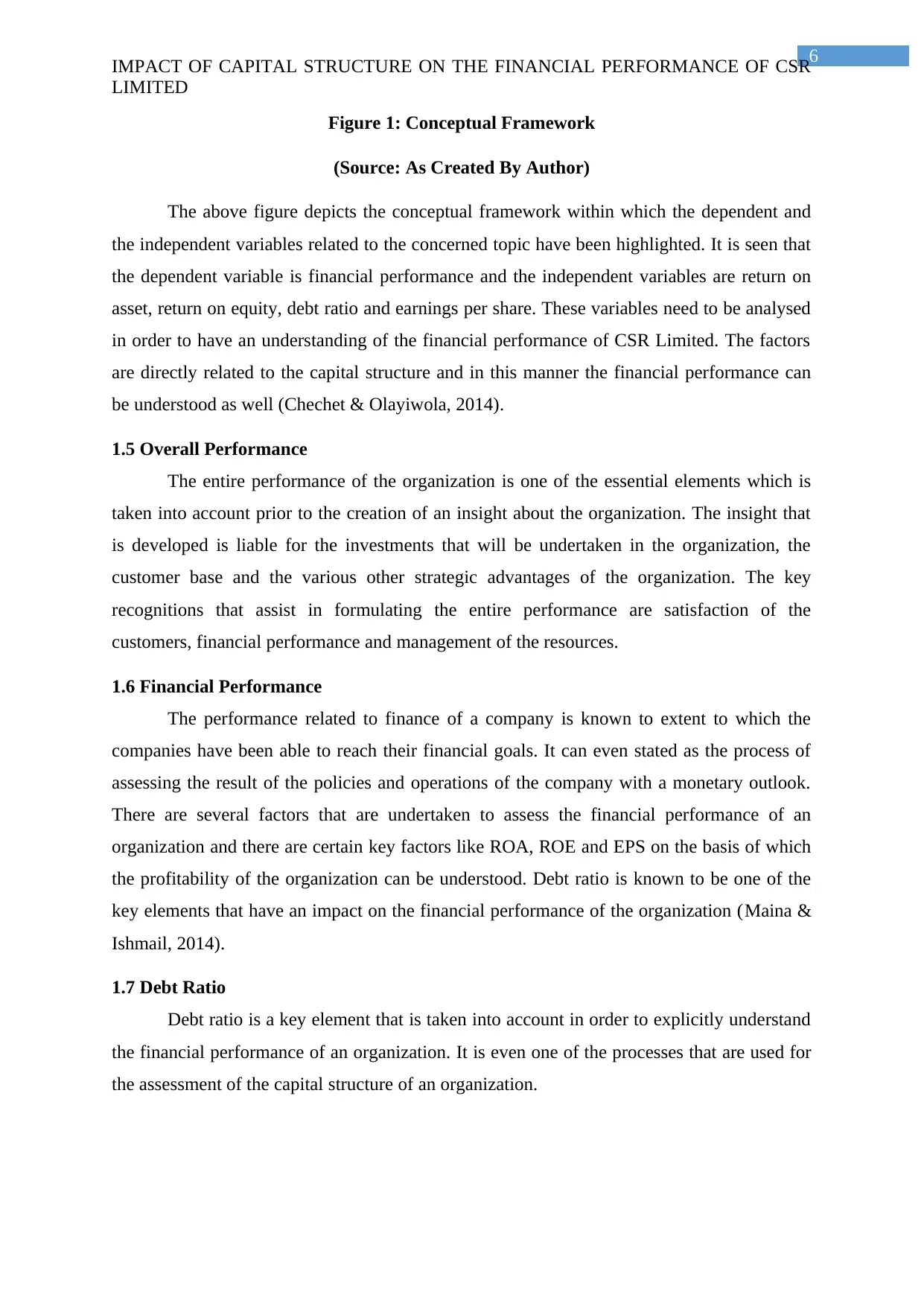
6
IMPACT OF CAPITAL STRUCTURE ON THE FINANCIAL PERFORMANCE OF CSR
LIMITED
Figure 1: Conceptual Framework
(Source: As Created By Author)
The above figure depicts the conceptual framework within which the dependent and
the independent variables related to the concerned topic have been highlighted. It is seen that
the dependent variable is financial performance and the independent variables are return on
asset, return on equity, debt ratio and earnings per share. These variables need to be analysed
in order to have an understanding of the financial performance of CSR Limited. The factors
are directly related to the capital structure and in this manner the financial performance can
be understood as well (Chechet & Olayiwola, 2014).
1.5 Overall Performance
The entire performance of the organization is one of the essential elements which is
taken into account prior to the creation of an insight about the organization. The insight that
is developed is liable for the investments that will be undertaken in the organization, the
customer base and the various other strategic advantages of the organization. The key
recognitions that assist in formulating the entire performance are satisfaction of the
customers, financial performance and management of the resources.
1.6 Financial Performance
The performance related to finance of a company is known to extent to which the
companies have been able to reach their financial goals. It can even stated as the process of
assessing the result of the policies and operations of the company with a monetary outlook.
There are several factors that are undertaken to assess the financial performance of an
organization and there are certain key factors like ROA, ROE and EPS on the basis of which
the profitability of the organization can be understood. Debt ratio is known to be one of the
key elements that have an impact on the financial performance of the organization (Maina &
Ishmail, 2014).
1.7 Debt Ratio
Debt ratio is a key element that is taken into account in order to explicitly understand
the financial performance of an organization. It is even one of the processes that are used for
the assessment of the capital structure of an organization.
IMPACT OF CAPITAL STRUCTURE ON THE FINANCIAL PERFORMANCE OF CSR
LIMITED
Figure 1: Conceptual Framework
(Source: As Created By Author)
The above figure depicts the conceptual framework within which the dependent and
the independent variables related to the concerned topic have been highlighted. It is seen that
the dependent variable is financial performance and the independent variables are return on
asset, return on equity, debt ratio and earnings per share. These variables need to be analysed
in order to have an understanding of the financial performance of CSR Limited. The factors
are directly related to the capital structure and in this manner the financial performance can
be understood as well (Chechet & Olayiwola, 2014).
1.5 Overall Performance
The entire performance of the organization is one of the essential elements which is
taken into account prior to the creation of an insight about the organization. The insight that
is developed is liable for the investments that will be undertaken in the organization, the
customer base and the various other strategic advantages of the organization. The key
recognitions that assist in formulating the entire performance are satisfaction of the
customers, financial performance and management of the resources.
1.6 Financial Performance
The performance related to finance of a company is known to extent to which the
companies have been able to reach their financial goals. It can even stated as the process of
assessing the result of the policies and operations of the company with a monetary outlook.
There are several factors that are undertaken to assess the financial performance of an
organization and there are certain key factors like ROA, ROE and EPS on the basis of which
the profitability of the organization can be understood. Debt ratio is known to be one of the
key elements that have an impact on the financial performance of the organization (Maina &
Ishmail, 2014).
1.7 Debt Ratio
Debt ratio is a key element that is taken into account in order to explicitly understand
the financial performance of an organization. It is even one of the processes that are used for
the assessment of the capital structure of an organization.
Paraphrase This Document
Need a fresh take? Get an instant paraphrase of this document with our AI Paraphraser
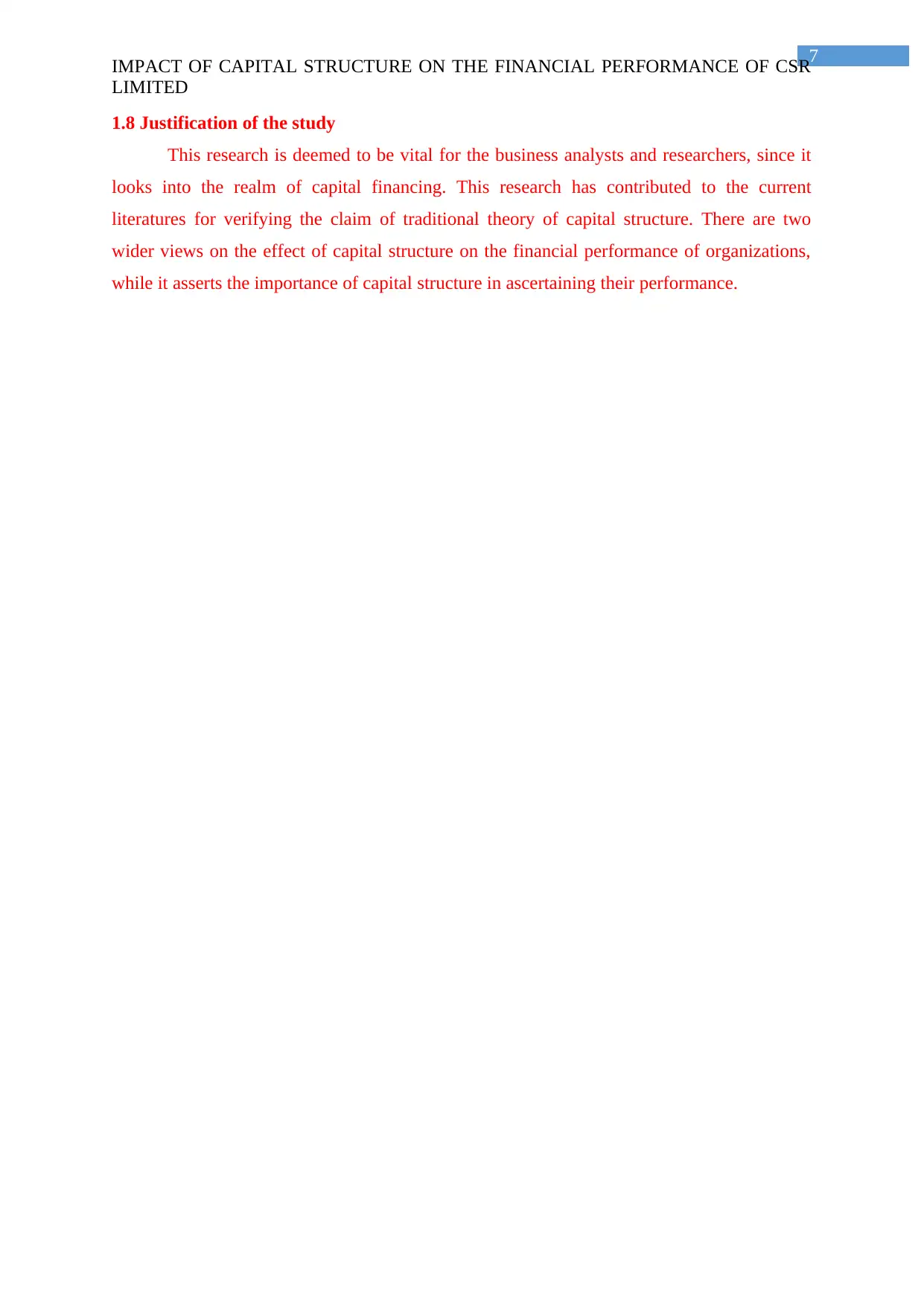
7
IMPACT OF CAPITAL STRUCTURE ON THE FINANCIAL PERFORMANCE OF CSR
LIMITED
1.8 Justification of the study
This research is deemed to be vital for the business analysts and researchers, since it
looks into the realm of capital financing. This research has contributed to the current
literatures for verifying the claim of traditional theory of capital structure. There are two
wider views on the effect of capital structure on the financial performance of organizations,
while it asserts the importance of capital structure in ascertaining their performance.
IMPACT OF CAPITAL STRUCTURE ON THE FINANCIAL PERFORMANCE OF CSR
LIMITED
1.8 Justification of the study
This research is deemed to be vital for the business analysts and researchers, since it
looks into the realm of capital financing. This research has contributed to the current
literatures for verifying the claim of traditional theory of capital structure. There are two
wider views on the effect of capital structure on the financial performance of organizations,
while it asserts the importance of capital structure in ascertaining their performance.
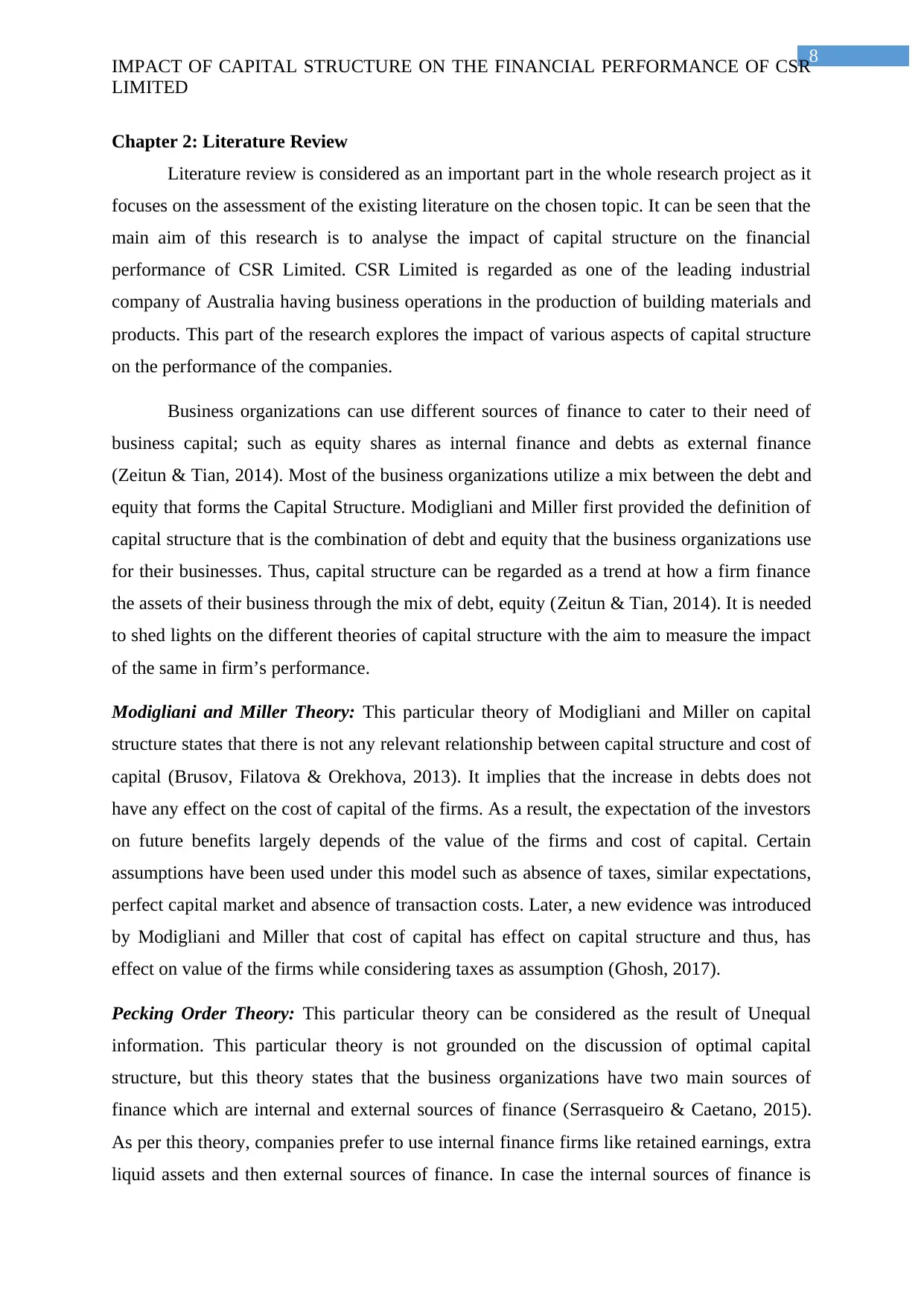
8
IMPACT OF CAPITAL STRUCTURE ON THE FINANCIAL PERFORMANCE OF CSR
LIMITED
Chapter 2: Literature Review
Literature review is considered as an important part in the whole research project as it
focuses on the assessment of the existing literature on the chosen topic. It can be seen that the
main aim of this research is to analyse the impact of capital structure on the financial
performance of CSR Limited. CSR Limited is regarded as one of the leading industrial
company of Australia having business operations in the production of building materials and
products. This part of the research explores the impact of various aspects of capital structure
on the performance of the companies.
Business organizations can use different sources of finance to cater to their need of
business capital; such as equity shares as internal finance and debts as external finance
(Zeitun & Tian, 2014). Most of the business organizations utilize a mix between the debt and
equity that forms the Capital Structure. Modigliani and Miller first provided the definition of
capital structure that is the combination of debt and equity that the business organizations use
for their businesses. Thus, capital structure can be regarded as a trend at how a firm finance
the assets of their business through the mix of debt, equity (Zeitun & Tian, 2014). It is needed
to shed lights on the different theories of capital structure with the aim to measure the impact
of the same in firm’s performance.
Modigliani and Miller Theory: This particular theory of Modigliani and Miller on capital
structure states that there is not any relevant relationship between capital structure and cost of
capital (Brusov, Filatova & Orekhova, 2013). It implies that the increase in debts does not
have any effect on the cost of capital of the firms. As a result, the expectation of the investors
on future benefits largely depends of the value of the firms and cost of capital. Certain
assumptions have been used under this model such as absence of taxes, similar expectations,
perfect capital market and absence of transaction costs. Later, a new evidence was introduced
by Modigliani and Miller that cost of capital has effect on capital structure and thus, has
effect on value of the firms while considering taxes as assumption (Ghosh, 2017).
Pecking Order Theory: This particular theory can be considered as the result of Unequal
information. This particular theory is not grounded on the discussion of optimal capital
structure, but this theory states that the business organizations have two main sources of
finance which are internal and external sources of finance (Serrasqueiro & Caetano, 2015).
As per this theory, companies prefer to use internal finance firms like retained earnings, extra
liquid assets and then external sources of finance. In case the internal sources of finance is
IMPACT OF CAPITAL STRUCTURE ON THE FINANCIAL PERFORMANCE OF CSR
LIMITED
Chapter 2: Literature Review
Literature review is considered as an important part in the whole research project as it
focuses on the assessment of the existing literature on the chosen topic. It can be seen that the
main aim of this research is to analyse the impact of capital structure on the financial
performance of CSR Limited. CSR Limited is regarded as one of the leading industrial
company of Australia having business operations in the production of building materials and
products. This part of the research explores the impact of various aspects of capital structure
on the performance of the companies.
Business organizations can use different sources of finance to cater to their need of
business capital; such as equity shares as internal finance and debts as external finance
(Zeitun & Tian, 2014). Most of the business organizations utilize a mix between the debt and
equity that forms the Capital Structure. Modigliani and Miller first provided the definition of
capital structure that is the combination of debt and equity that the business organizations use
for their businesses. Thus, capital structure can be regarded as a trend at how a firm finance
the assets of their business through the mix of debt, equity (Zeitun & Tian, 2014). It is needed
to shed lights on the different theories of capital structure with the aim to measure the impact
of the same in firm’s performance.
Modigliani and Miller Theory: This particular theory of Modigliani and Miller on capital
structure states that there is not any relevant relationship between capital structure and cost of
capital (Brusov, Filatova & Orekhova, 2013). It implies that the increase in debts does not
have any effect on the cost of capital of the firms. As a result, the expectation of the investors
on future benefits largely depends of the value of the firms and cost of capital. Certain
assumptions have been used under this model such as absence of taxes, similar expectations,
perfect capital market and absence of transaction costs. Later, a new evidence was introduced
by Modigliani and Miller that cost of capital has effect on capital structure and thus, has
effect on value of the firms while considering taxes as assumption (Ghosh, 2017).
Pecking Order Theory: This particular theory can be considered as the result of Unequal
information. This particular theory is not grounded on the discussion of optimal capital
structure, but this theory states that the business organizations have two main sources of
finance which are internal and external sources of finance (Serrasqueiro & Caetano, 2015).
As per this theory, companies prefer to use internal finance firms like retained earnings, extra
liquid assets and then external sources of finance. In case the internal sources of finance is
⊘ This is a preview!⊘
Do you want full access?
Subscribe today to unlock all pages.

Trusted by 1+ million students worldwide
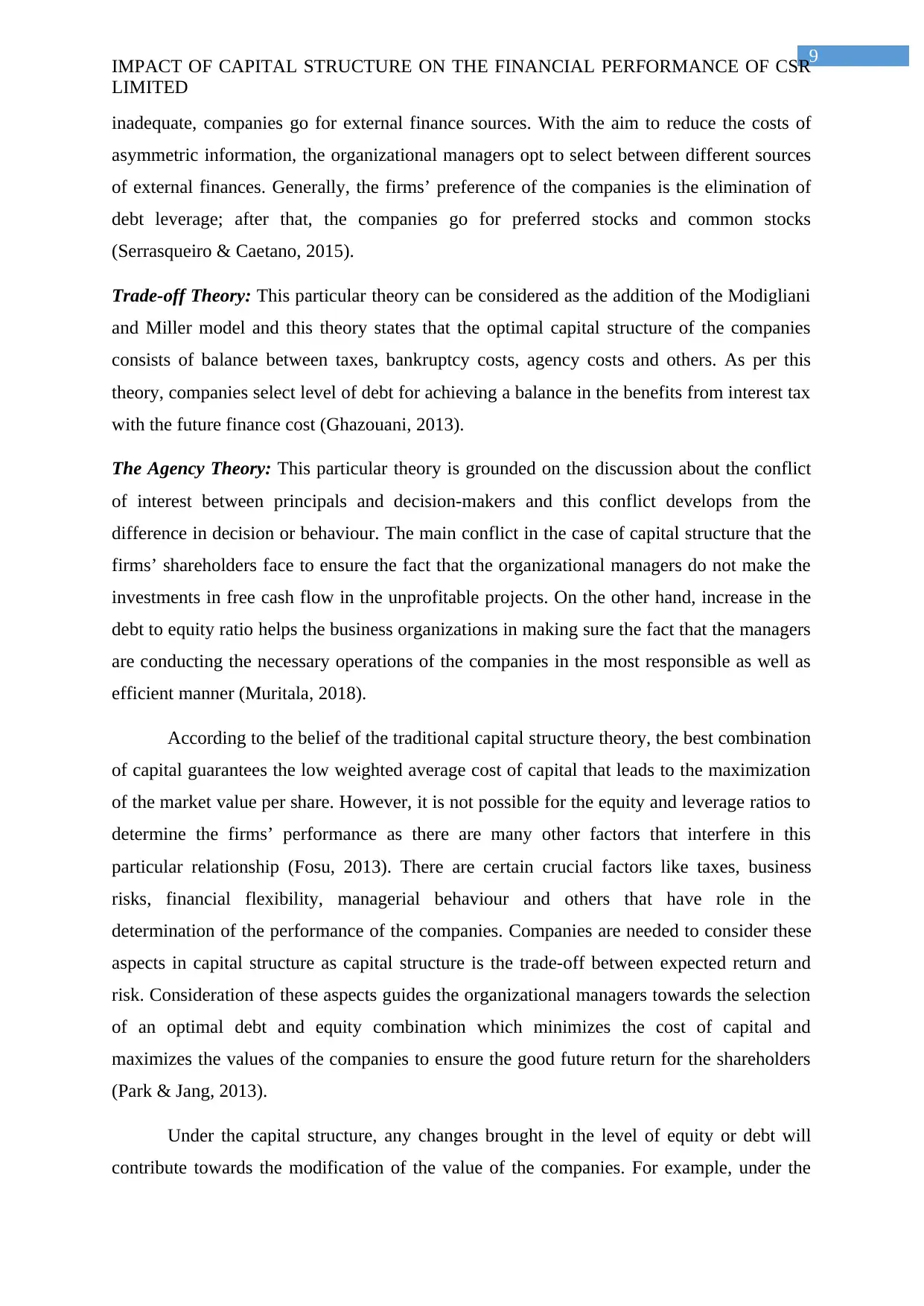
9
IMPACT OF CAPITAL STRUCTURE ON THE FINANCIAL PERFORMANCE OF CSR
LIMITED
inadequate, companies go for external finance sources. With the aim to reduce the costs of
asymmetric information, the organizational managers opt to select between different sources
of external finances. Generally, the firms’ preference of the companies is the elimination of
debt leverage; after that, the companies go for preferred stocks and common stocks
(Serrasqueiro & Caetano, 2015).
Trade-off Theory: This particular theory can be considered as the addition of the Modigliani
and Miller model and this theory states that the optimal capital structure of the companies
consists of balance between taxes, bankruptcy costs, agency costs and others. As per this
theory, companies select level of debt for achieving a balance in the benefits from interest tax
with the future finance cost (Ghazouani, 2013).
The Agency Theory: This particular theory is grounded on the discussion about the conflict
of interest between principals and decision-makers and this conflict develops from the
difference in decision or behaviour. The main conflict in the case of capital structure that the
firms’ shareholders face to ensure the fact that the organizational managers do not make the
investments in free cash flow in the unprofitable projects. On the other hand, increase in the
debt to equity ratio helps the business organizations in making sure the fact that the managers
are conducting the necessary operations of the companies in the most responsible as well as
efficient manner (Muritala, 2018).
According to the belief of the traditional capital structure theory, the best combination
of capital guarantees the low weighted average cost of capital that leads to the maximization
of the market value per share. However, it is not possible for the equity and leverage ratios to
determine the firms’ performance as there are many other factors that interfere in this
particular relationship (Fosu, 2013). There are certain crucial factors like taxes, business
risks, financial flexibility, managerial behaviour and others that have role in the
determination of the performance of the companies. Companies are needed to consider these
aspects in capital structure as capital structure is the trade-off between expected return and
risk. Consideration of these aspects guides the organizational managers towards the selection
of an optimal debt and equity combination which minimizes the cost of capital and
maximizes the values of the companies to ensure the good future return for the shareholders
(Park & Jang, 2013).
Under the capital structure, any changes brought in the level of equity or debt will
contribute towards the modification of the value of the companies. For example, under the
IMPACT OF CAPITAL STRUCTURE ON THE FINANCIAL PERFORMANCE OF CSR
LIMITED
inadequate, companies go for external finance sources. With the aim to reduce the costs of
asymmetric information, the organizational managers opt to select between different sources
of external finances. Generally, the firms’ preference of the companies is the elimination of
debt leverage; after that, the companies go for preferred stocks and common stocks
(Serrasqueiro & Caetano, 2015).
Trade-off Theory: This particular theory can be considered as the addition of the Modigliani
and Miller model and this theory states that the optimal capital structure of the companies
consists of balance between taxes, bankruptcy costs, agency costs and others. As per this
theory, companies select level of debt for achieving a balance in the benefits from interest tax
with the future finance cost (Ghazouani, 2013).
The Agency Theory: This particular theory is grounded on the discussion about the conflict
of interest between principals and decision-makers and this conflict develops from the
difference in decision or behaviour. The main conflict in the case of capital structure that the
firms’ shareholders face to ensure the fact that the organizational managers do not make the
investments in free cash flow in the unprofitable projects. On the other hand, increase in the
debt to equity ratio helps the business organizations in making sure the fact that the managers
are conducting the necessary operations of the companies in the most responsible as well as
efficient manner (Muritala, 2018).
According to the belief of the traditional capital structure theory, the best combination
of capital guarantees the low weighted average cost of capital that leads to the maximization
of the market value per share. However, it is not possible for the equity and leverage ratios to
determine the firms’ performance as there are many other factors that interfere in this
particular relationship (Fosu, 2013). There are certain crucial factors like taxes, business
risks, financial flexibility, managerial behaviour and others that have role in the
determination of the performance of the companies. Companies are needed to consider these
aspects in capital structure as capital structure is the trade-off between expected return and
risk. Consideration of these aspects guides the organizational managers towards the selection
of an optimal debt and equity combination which minimizes the cost of capital and
maximizes the values of the companies to ensure the good future return for the shareholders
(Park & Jang, 2013).
Under the capital structure, any changes brought in the level of equity or debt will
contribute towards the modification of the value of the companies. For example, under the
Paraphrase This Document
Need a fresh take? Get an instant paraphrase of this document with our AI Paraphraser
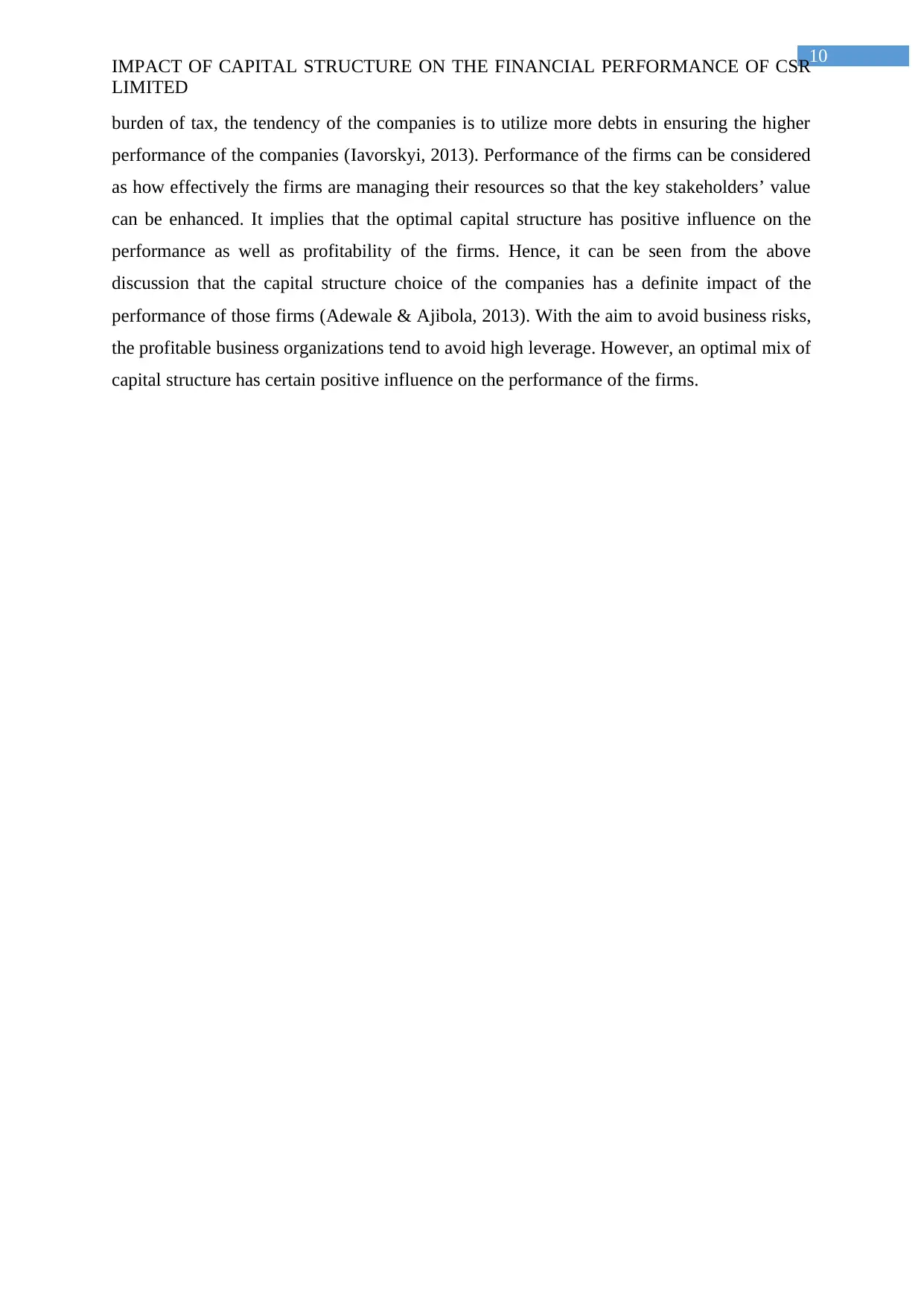
10
IMPACT OF CAPITAL STRUCTURE ON THE FINANCIAL PERFORMANCE OF CSR
LIMITED
burden of tax, the tendency of the companies is to utilize more debts in ensuring the higher
performance of the companies (Iavorskyi, 2013). Performance of the firms can be considered
as how effectively the firms are managing their resources so that the key stakeholders’ value
can be enhanced. It implies that the optimal capital structure has positive influence on the
performance as well as profitability of the firms. Hence, it can be seen from the above
discussion that the capital structure choice of the companies has a definite impact of the
performance of those firms (Adewale & Ajibola, 2013). With the aim to avoid business risks,
the profitable business organizations tend to avoid high leverage. However, an optimal mix of
capital structure has certain positive influence on the performance of the firms.
IMPACT OF CAPITAL STRUCTURE ON THE FINANCIAL PERFORMANCE OF CSR
LIMITED
burden of tax, the tendency of the companies is to utilize more debts in ensuring the higher
performance of the companies (Iavorskyi, 2013). Performance of the firms can be considered
as how effectively the firms are managing their resources so that the key stakeholders’ value
can be enhanced. It implies that the optimal capital structure has positive influence on the
performance as well as profitability of the firms. Hence, it can be seen from the above
discussion that the capital structure choice of the companies has a definite impact of the
performance of those firms (Adewale & Ajibola, 2013). With the aim to avoid business risks,
the profitable business organizations tend to avoid high leverage. However, an optimal mix of
capital structure has certain positive influence on the performance of the firms.

11
IMPACT OF CAPITAL STRUCTURE ON THE FINANCIAL PERFORMANCE OF CSR
LIMITED
Chapter 3: Research Methodology
The research methodology deals with the various designs and structure which is
followed for the purpose of this research(Dang &Pheng, 2015).The company is a specific
which gives a specific area for research and therefore the research would be dependent on
qualitative data as well quantitative data for analysis.
3.1 Research Outline
The research would be using a variety of tools and approaches for the purpose of
effective data analysis. The research philosophy and approach would be considered on the
basis of the nature of the research. The main source of data on which the research paper
would be relying on is secondary source of data and would be using significant tools such as
excel and statistical tools.
3.2 Research Philosophy
This deals with the beliefs as to the nature and source of the data and how the same
data is to be analysed by the management of the company. The research philosophy helps in
conducting an in-depth research on the topic applying all relevant theories and models
(Dumay & Cai, 2015). The research would be applying the model of positivism which would
help in effectively widening the perspective of the research.
3.3 Research Approach
The research topic focuses on the impact of capital structure on the business of CSR
ltd. The research approach which is selected for this research would be a deductive approach
as already established theories and concepts which are applicable to the company are to be
considered for this research. The capital structure theories are already established and the
same would be used considering what is applicable to CSR Ltd
3.4 Research Design
The research would be following a descriptive approach as there are numerous
theories which are present relating to capital structure and the same needs to be analysed on
the basis of the selected company (Marczyk, DeMatteo & Festinger, 2017).
3.5 Data Collection Method
The research would be dependent on qualitative data as well quantitative data for
analysis and would be using secondary data which can be obtained from company annual
reports and official websites (Brannen, 2017).
IMPACT OF CAPITAL STRUCTURE ON THE FINANCIAL PERFORMANCE OF CSR
LIMITED
Chapter 3: Research Methodology
The research methodology deals with the various designs and structure which is
followed for the purpose of this research(Dang &Pheng, 2015).The company is a specific
which gives a specific area for research and therefore the research would be dependent on
qualitative data as well quantitative data for analysis.
3.1 Research Outline
The research would be using a variety of tools and approaches for the purpose of
effective data analysis. The research philosophy and approach would be considered on the
basis of the nature of the research. The main source of data on which the research paper
would be relying on is secondary source of data and would be using significant tools such as
excel and statistical tools.
3.2 Research Philosophy
This deals with the beliefs as to the nature and source of the data and how the same
data is to be analysed by the management of the company. The research philosophy helps in
conducting an in-depth research on the topic applying all relevant theories and models
(Dumay & Cai, 2015). The research would be applying the model of positivism which would
help in effectively widening the perspective of the research.
3.3 Research Approach
The research topic focuses on the impact of capital structure on the business of CSR
ltd. The research approach which is selected for this research would be a deductive approach
as already established theories and concepts which are applicable to the company are to be
considered for this research. The capital structure theories are already established and the
same would be used considering what is applicable to CSR Ltd
3.4 Research Design
The research would be following a descriptive approach as there are numerous
theories which are present relating to capital structure and the same needs to be analysed on
the basis of the selected company (Marczyk, DeMatteo & Festinger, 2017).
3.5 Data Collection Method
The research would be dependent on qualitative data as well quantitative data for
analysis and would be using secondary data which can be obtained from company annual
reports and official websites (Brannen, 2017).
⊘ This is a preview!⊘
Do you want full access?
Subscribe today to unlock all pages.

Trusted by 1+ million students worldwide
1 out of 26
Related Documents
Your All-in-One AI-Powered Toolkit for Academic Success.
+13062052269
info@desklib.com
Available 24*7 on WhatsApp / Email
![[object Object]](/_next/static/media/star-bottom.7253800d.svg)
Unlock your academic potential
Copyright © 2020–2025 A2Z Services. All Rights Reserved. Developed and managed by ZUCOL.





